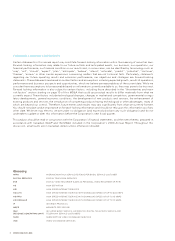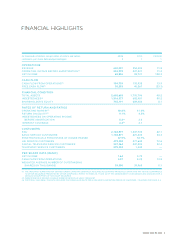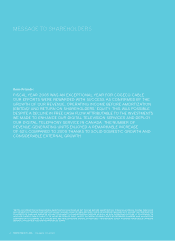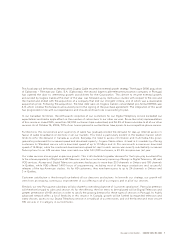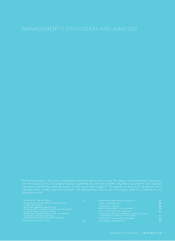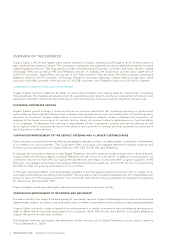Cogeco 2006 Annual Report Download - page 14
Download and view the complete annual report
Please find page 14 of the 2006 Cogeco annual report below. You can navigate through the pages in the report by either clicking on the pages listed below, or by using the keyword search tool below to find specific information within the annual report.12 COGECO CABLE INC. 2006 Management’s Discussion and Analysis
AMORTIZATION POLICIES AND USEFUL LIVES
Cogeco Cable amortizes fi xed assets over the estimated useful lives of the items. In estimating useful lives, the Corporation
considers such factors as life expectancy of the assets, changing technologies and cable industry trends. The Corporation
reviews its useful lives estimates on a regular basis. If changes in the above-mentioned factors happen more quickly than
anticipated, Cogeco Cable might have to shorten the estimated life of certain assets, which could result in a higher
amortization expense in future periods.
CAPITALIZATION OF LAUNCH COSTS, COSTS TO ACQUIRE CUSTOMERS AND SUBSIDIES ON EQUIPMENT
The Corporation incurs signifi cant marketing costs during the launch of new services, such as new digital tiers, VOD, HSI
and Digital Telephony services. These costs are capitalized and amortized over a period of fi ve years, the estimated period
during which these costs are to provide benefi t. Cogeco Cable’s experience indicates that it takes approximately fi ve years
for the new services to reach a certain maturity level.
In addition, signifi cant costs are incurred to reconnect customers and to attract new cable, HSI and Digital Telephony
customers. These costs include material and labour costs incurred to reconnect customers as well as subsidies given to
customers on the sale of home terminal devices. Reconnect costs are capitalized up to a maximum amount not exceeding
the revenue generated by the reconnect activity. These costs are amortized over a period of four years, which represent
the average life of a customer’s subscription since no term is specifi ed for which the customer will receive the services.
The average life of a customer’s subscription is reviewed annually and changes could have a signifi cant impact on the
amortization expense.
IMPAIRMENT OF LONG-LIVED ASSETS
The Corporation reviews, when a triggering event occurs, the carrying values of its long-lived assets by comparing the
carrying amount of the asset or group of assets to the expected future undiscounted cash fl ows to be generated by
the asset or group of assets. An impairment loss is recognized when the carrying amount of an asset or group of assets
held for use exceeds the sum of the undiscounted cash fl ows expected from its use and eventual disposition. The impairment
loss is measured as the amount by which the asset carrying amount exceeds its fair value. Future cash fl ows are based on
internal forecasts and consequently, considerable management judgement is necessary to estimate future cash fl ows.
Signifi cant changes in assumptions could result in impairment of these assets.
IMPAIRMENT OF CUSTOMER BASE
The valuation of customer base is subject to review for impairment whenever signifi cant events or changes in circumstances
occur, to determine if carrying value can be recovered. In conducting impairment testing, the Corporation compares the
carrying value to the sum of discounted cash fl ows. Future cash fl ows are based on internal forecasts and discounted by
using a weighted average cost of capital rate. Considerable management judgment is necessary to estimate future cash
fl ows. Signifi cant changes in assumptions could result in impairment of this asset. The Corporation’s impairment test is
performed as at August 31 of each fi scal year.
INCOME TAXES
The Corporation uses assumptions to estimate income tax expenses as well as future income tax liabilities. This process
includes estimating the actual amount of income taxes payable and evaluating income tax loss carry-forwards and
temporary differences as a result of differences between the values of the items reported for accounting and tax purposes.
Realization of future income tax assets is dependent upon generating suffi cient taxable income during the period in which
temporary differences are expected to be recovered or settled. The likelihood of realization of future income tax assets is
evaluated by considering such factors as estimated future earnings based on internal forecasts, prudent and feasible tax
planning strategies and reversal of temporary differences that result in future income tax liabilities. Future income tax
assets and liabilities are calculated according to enacted or substantially enacted income tax rates expected to be applied
to taxable income in the years in which those temporary differences are expected to be recovered or settled. Future income
tax assets are recognized only to the extend that, in the opinion of management, it is more likely than not that the future
income tax assets will be realized. Accordingly, changes in assumptions will directly impact the reported amount of income
tax expenses.


